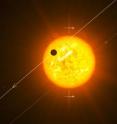Turning planetary theory upside down
The discovery of nine new transiting exoplanets is announced today at the RAS National Astronomy Meeting. When these new results were combined with earlier observations of transiting exoplanets astronomers were surprised to find that six out of a larger sample of 27 were found to be orbiting in the opposite direction to the rotation of their host star -- the exact reverse of what is seen in our own solar system. "This is a real bomb we are dropping into the field of exoplanets," says Amaury Triaud, a PhD student at the Geneva Observatory who, with Andrew Cameron and Didier Queloz, leads a major part of the observational campaign.
Planets are thought to form in the disc of gas and dust encircling a young star. This proto-planetary disc rotates in the same direction as the star itself, and up to now it was expected that planets that form from the disc would all orbit in more or less the same plane, and that they would move along their orbits in the same direction as the star's rotation. This is the case for the planets in the Solar System.
After the initial detection of the nine new exoplanets [1] with the Wide Angle Search for Planets (WASP, [2]), the team of astronomers used the HARPS spectrograph on the 3.6-metre ESO telescope at the La Silla observatory in Chile, along with data from the Swiss Euler telescope, also at La Silla, and data from other telescopes to confirm the discoveries and characterise the transiting exoplanets [3] found in both the new and older surveys.
Surprisingly, when the team combined the new data with older observations they found that more than half of all the hot Jupiters [4] studied have orbits that are misaligned with the rotation axis of their parent stars. They even found that six exoplanets in this extended study (of which two are new discoveries) have retrograde motion: they orbit their star in the "wrong" direction.
"The new results really challenge the conventional wisdom that planets should always orbit in the same direction as their stars spin," says Andrew Cameron of the University of St Andrews, who presented the new results at the RAS National Astronomy Meeting (NAM2010) in Glasgow this week.
In the 15 years since the first hot Jupiters were discovered, their origin has been a puzzle. These are planets with masses similar to or greater than that of Jupiter, but that orbit very close to their suns. The cores of giant planets are thought to form from a mix of rock and ice particles found only in the cold outer reaches of planetary systems. Hot Jupiters must therefore form far from their star and subsequently migrate inwards to orbits much closer to the parent star. Many astronomers believed this was due to gravitational interactions with the disc of dust from which they formed. This scenario takes place over a few million years and results in an orbit aligned with the rotation axis of the parent star. It would also allow Earth-like rocky planets to form subsequently, but unfortunately it cannot account for the new observations.
To account for the new retrograde exoplanets an alternative migration theory suggests that the proximity of hot Jupiters to their stars is not due to interactions with the dust disc at all, but to a slower evolution process involving a gravitational tug-of-war with more distant planetary or stellar companions over hundreds of millions of years. After these disturbances have bounced a giant exoplanet into a tilted and elongated orbit it would suffer tidal friction, losing energy every time it swung close to the star. It would eventually become parked in a near circular, but randomly tilted, orbit close to the star. "A dramatic side-effect of this process is that it would wipe out any other smaller Earth-like planet in these systems," says Didier Queloz of Geneva Observatory.
Two of the newly discovered retrograde planets have already been found to have more distant, massive companions that could potentially be the cause of the upset. These new results will trigger an intensive search for additional bodies in other planetary systems.
This research was presented at the Royal Astronomical Society National Astronomy Meeting (NAM2010) that is taking place this week in Glasgow, Scotland. Nine publications submitted to international journals will be released on this occasion, four of them using data from ESO facilities. On the same occasion, the WASP consortium was awarded the 2010 Royal Astronomical Society Group Achievement Award.
Source: ESO
Articles on the same topic
- Astronomers find 9 new planets and upset the theory of planetary formationTue, 13 Apr 2010, 19:31:24 UTC
Other sources
- Technological Advances Bring Exoplanets into Clearer Viewfrom Scientific AmericanWed, 14 Apr 2010, 20:49:11 UTC
- Scientists in a Spin Over Exoplanet Orbitsfrom CBSNews - ScienceWed, 14 Apr 2010, 16:56:50 UTC
- Scientists in a Spin Over Exoplanet Orbitsfrom CBSNews - ScienceWed, 14 Apr 2010, 1:56:24 UTC
- Astronomers find 9 new planets and upset the theory of planetary formationfrom Science BlogTue, 13 Apr 2010, 19:28:16 UTC
- Scientists in a Spin Over Exoplanet Orbitsfrom CBSNews - ScienceTue, 13 Apr 2010, 19:07:26 UTC
- Scientists in a Spin Over Exoplanet Orbitsfrom CBSNews - ScienceTue, 13 Apr 2010, 17:14:17 UTC
- Exoplanet theory is proven wrongfrom UPITue, 13 Apr 2010, 17:07:24 UTC
- Distant planets rattle theories with their orbitfrom LA Times - ScienceTue, 13 Apr 2010, 16:21:24 UTC
- Turning planetary theory upside down: Nine new exoplanets found, some with retrograde orbitsfrom Science DailyTue, 13 Apr 2010, 12:35:28 UTC
- Turning Planetary Theory Upside Down (w/ Video)from PhysorgTue, 13 Apr 2010, 11:35:14 UTC
- Backwards Alien Planets Challenge Theoriesfrom Space.comTue, 13 Apr 2010, 11:07:23 UTC
